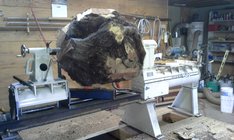What’s the best way to weigh down a lathe ? Sandbags?
-
Beware of Counterfeit Woodturning Tools (click here for details) -
Johnathan Silwones is starting a new AAW chapter, Southern Alleghenies Woodturners, in Johnstown, PA. (click here for details) -
Congratulations to Peter Jacobson for "Red Winged Burl Bowl" being selected as Turning of the Week for April 29, 2024 (click here for details) -
Welcome new registering member. Your username must be your real First and Last name (for example: John Doe). "Screen names" and "handles" are not allowed and your registration will be deleted if you don't use your real name. Also, do not use all caps nor all lower case.
You are using an out of date browser. It may not display this or other websites correctly.
You should upgrade or use an alternative browser.
You should upgrade or use an alternative browser.
Bolted my lathe to the floor of my garage but still jumps with big crotch wood… what else can I do?
- Thread starter Darryl Doonan
- Start date
Run it slower till you get some balance. You have it bolted down so the energy has to go somewhere, you may wind up damaging your lathe over time.
You bolted it to a concrete slab and it still moves? You used heavy enough anchors? What lathe do you have? Sandbags will do nothing compared to bolting to concrete.
mount a router in your tool rest, with cutter to power on and take off high spots, while you use hand wheel to turn the piece by hand, at least until you get the piece mostly rounded. kind of slow, but I have seen videos where the router was used on some 30 inch bowls even to do shaping of the exterior and patt of the scooping out the interior.
I have a midi lathe and the best thing I did to stabilize it was increase the footprint since I didn't want to bolt it to the floor. I watched a you tube from Lyle Jamieson on stabilizing lathes and did what he said. It helped a lot. I made a lift lock and roll for the lathe and it added 13" to the width and 3" to the length of the footprint. Next would be to make sure the weight of the lathe is equally supported on each foot. I also have toolbox mounted to the lathe which weighs about 100 pounds loaded. I would take the advice listed above also. Sorry, after posting this I read your post again and realized you already bolted it to the floor so my advice doesn't apply.
You need to start slow and knock off the high points before turning up the speed. The wood will break before the lathe, and that's a bad day for you. You're in the danger zone Darryl. I'm sure others will chime in with their balancing tips, but you need to be more thoughtful on what you're doing.
- Joined
- Apr 27, 2004
- Messages
- 8,650
- Likes
- 5,008
- Location
- Lakeland, Florida
- Website
- www.hockenberywoodturning.com
I turn a lot of crotch pieces for NE bowls. Largest run 18” diameter.What’s the best way to weigh down a lathe ? Sandbags?
I do my layout with disc under the crotch to find center.
Then I mount between centers. If needed I move the tail center to balance for weight - put heavy side straight up move the center up a bit toward the heavy side. Keep repeating untill it spins by hand nicely not dropping to a heavy side down.
Take off some wood then set the 3 rims to the same height.
These are some demo slides showing how I align the rims in two steps.
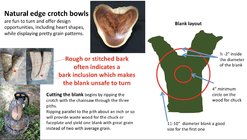 .
. 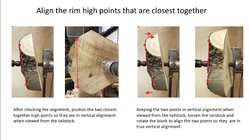 .
. 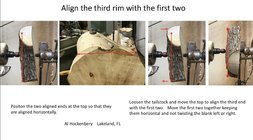
My lathe isn’t bolted down but it weighs over a 1000 lbs with attachments.
Blanks with unbalanced weight will vibrate at some speed. I accept some vibration when I begin roughing.
I find the best speed by increasing from lowest up to where it starts to vibrate unacceptedly.
Then I increase the speed a bit to check for a higher speed with acceptable vibration and fine tune on that or lowered the SuperDrive to the acceptable vibration.
Last edited:
- Joined
- Dec 23, 2015
- Messages
- 62
- Likes
- 169
- Location
- Ringgold, Georgia
- Website
- www.rickurbanwoodturner.com
How big a krotch?
What kind of lathe?
How are you mounting?
How fast are you trying to turn?
Are you able to turn slower?
How close to round are you making your blank?
Provide answers to these questions, and you might get some good advice toward avoiding other dangers you may be unknowingly creating.
What kind of lathe?
How are you mounting?
How fast are you trying to turn?
Are you able to turn slower?
How close to round are you making your blank?
Provide answers to these questions, and you might get some good advice toward avoiding other dangers you may be unknowingly creating.
Darryl I've had the concrete floor flex where my lathe is bolted onto. so I will stop the lathe and set the spindle free, the piece then rotates with the heavy side down.
Then I will bold on some weight onto the back of the piece and rotate the piece and let it settle again, add or remove weight till it will not stop at one place.
The piece can then be turned at a regular speed, (just make sure the counter weights are not coming off as you spin it faster)
Oh yes, you might have to change the weights as you remove wood turning it, be safe.
Then I will bold on some weight onto the back of the piece and rotate the piece and let it settle again, add or remove weight till it will not stop at one place.
The piece can then be turned at a regular speed, (just make sure the counter weights are not coming off as you spin it faster)
Oh yes, you might have to change the weights as you remove wood turning it, be safe.
Can you post a photo of the lathe and stand? Depending on the equipment you might be able to make the structure more rigid.
As others said, getting the blank better balanced is the key. I use a 16” electric chainsaw and a 4” grinder with chain wheel to remove heavy areas, with the blank mounted between centers and held by the spindle lock.
As others said, getting the blank better balanced is the key. I use a 16” electric chainsaw and a 4” grinder with chain wheel to remove heavy areas, with the blank mounted between centers and held by the spindle lock.
I do a lot of crotch hollow-forms and do all trimming with a chainsaw.
- I have templates made of plastic 5-gal paint bucket lids or small plastic garbage can lids - all come with a little dimple in the center. Easy to position, use an awl to mark center, and chalk to mark perimeter. Then chainsaw accordingly.
- I position the blank for design, NOT for balance. If the blank has bark inclusions or interesting knots, I want those to show - I frequently reposition a balanced blank to grossly off-balance to show interesting attributes of the wood.
- To my thinking, increasing the width or the lathe footprint is better than bolting - lots of ways to do that
- If you turn larger off-balance blanks, get used to turning slower. I rarely get above 300-rpm until the balance is dead-nuts.
I'm always between centers except when hollowing - then, of course, it's balanced.
- I have templates made of plastic 5-gal paint bucket lids or small plastic garbage can lids - all come with a little dimple in the center. Easy to position, use an awl to mark center, and chalk to mark perimeter. Then chainsaw accordingly.
- I position the blank for design, NOT for balance. If the blank has bark inclusions or interesting knots, I want those to show - I frequently reposition a balanced blank to grossly off-balance to show interesting attributes of the wood.
- To my thinking, increasing the width or the lathe footprint is better than bolting - lots of ways to do that
- If you turn larger off-balance blanks, get used to turning slower. I rarely get above 300-rpm until the balance is dead-nuts.
I'm always between centers except when hollowing - then, of course, it's balanced.
john lucas
AAW Forum Expert
Increasing the footprint is fantastic. I keep saying I will do it but haven't. I had a friend who turned and hollowed off center pieces. It shook his Powermatic 3520 terribly. That's a 750lb lathe. He added 6 foot long 3" angle iron that was about 3/8" thick. totally solved the problem. He did have a machinist cut the top part off on the inboard tailstock side so he wouldn't trip over it. In my shop it would be too big of a trip hazard so I'm thinking about adding 3" wide by 1/2" thick steel and probably only 4 foot on the headstock side and 3 on the tailstock.
Doug, yes if you can trim it to a balanced piece that's the way to go, however that is not always possible, like this 32 inch root burl here, there are large voids right down to the centre, so that is where I will add weight to balance the piece.
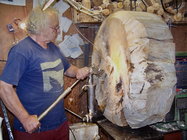
After shaping the outside I can then hold it with my Oneway Stronghold chuck and then hollow the piece.
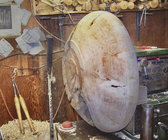
removed most of the inner wood here.
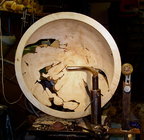
As for my lathe, it is heavy and bolted to a 10 inch I beam welded onto 12 inch high pressure pipes that are bolted to the concrete floor (6 drop in anchors).
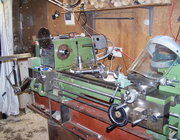

After shaping the outside I can then hold it with my Oneway Stronghold chuck and then hollow the piece.

removed most of the inner wood here.

As for my lathe, it is heavy and bolted to a 10 inch I beam welded onto 12 inch high pressure pipes that are bolted to the concrete floor (6 drop in anchors).

Last edited:
Balance the piece as you mount it. Using a faceplate or woodworm screw eliminates that possibility, so I generally don't use them at all. I use centers with points extended so I can let the blank spin freely. (love my Elio drive) When the heavy side drops, I rotate it 180° and with the help of gravity (and maybe loosening the tailstock slightly) I change the axis and try again. When you get it so that it will stop randomly, rather than the same heavy-side-down, you'll be able to run much faster with almost no vibration.
If you have a really big (like 20"+) blank, it can be sort of difficult, so I don't get it perfect, but getting it close helps a lot.
If you have a really big (like 20"+) blank, it can be sort of difficult, so I don't get it perfect, but getting it close helps a lot.
While I do not often turn off-balance pieces, I have never had my lathe move. I am the third owner (I know of) of my lathe - a Nova DVR XP. Some prior owner made the base for the lathe - base is about 60 x 24 inches (maybe a bit deeper). The frame (4 legs, frame at top, frame about a foot from the bottom) is all 3/8" thick angle iron, welded together. The lathe is mounted to the front with the bolts going through the front angle. There is another piece of 3/8" angle under the back of the ways, so that side is also securely bolted to the metal frame. The top of this stand is made from 2 x 12 lumber. I added 3/4" hardwood risers under each pair of bolts for the bed, and under the headstock - makes cleaning out the chips that get in there a lot easier. The whole thing just sits on the concrete floor of my shop. I have had the occasional vibration, but never had it move on me.
When I first got my 20" General lathe I made a weight box for the headstock. Had about 120 pounds of sand in it. Than I filled the hollow leg at the tailstock with another 100 pounds of sand. Than I added 120 pounds of sand under the bed. Not enough weight. Bolted it to the floor with large concrete anchors and problem solved......but now when you feel the ground shake it may not be an earthquake.
I turn some heavy eccentric wall art stuff on the outboard side in the 3 to 4 foot diameter range. With the lathe bolted down I didn't have much vibration but realized my bearings and spindle would have a short life with that kind of punishment. I made a 28" diameter faceplate out of baltic birch. On the back side I bolt weights to counteract the unbalance and all is good. Picture is my first use and I found as material is removed the weights had to be readjusted.
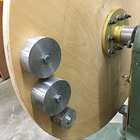
I turn some heavy eccentric wall art stuff on the outboard side in the 3 to 4 foot diameter range. With the lathe bolted down I didn't have much vibration but realized my bearings and spindle would have a short life with that kind of punishment. I made a 28" diameter faceplate out of baltic birch. On the back side I bolt weights to counteract the unbalance and all is good. Picture is my first use and I found as material is removed the weights had to be readjusted.

Do you all think Darryl is coming back?
For the original question, (and when I didn't have the strength or patience to find the center of balance in large chunks) I weighted my Problematic 4224 down with 11 bags of tube sand (80 pounds each) I cut a thick plywood shelf to fit between the legs and used a chain to support the center of it. It really tamed things and dampened vibration.
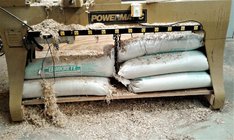

I also added weight - I put several bags of bird-shot in the cavity of the lathe - goal is to minimize the slight vibrations caused by slight imbalance
But I also extended the footprint with two objectives: 1) not being injured/killed and 2) my hollowing technique requires a higher spindle height. The beam under the headstock is a stack of 2x10 8-ft long and under both tailstock ends is a stack of 2x8 a little shorter. Add the Trex pieces serving as the feet and the cross-planks for standing, the additional height is 9-inchs. The platforms allow an ideal spindle height of 43" - the spindle height to the floor is 52" which is ideal for my hollowing method.
Regarding added mass, it's all about leverage. Ideally the added weight would be hard-fixed to the spindle - as that's not realistic, hard-fix as close as possible to the source.
Counter-weighting seems all about the mechanics - last thing I want is for one of my ill-thought gizmos to come apart and sling a counter-weight through the window
And back to the mundane, "not being injured/killed": most every log put on a lathe is off-balance to some degree. Allow the piece to communicate - if the vibration exceeds "gut-feel", the solution is NOT to tighten the lag bolts to the anchors or to the beam - the solution is to slow down. For what it's worth, the lag bolts securing my lathe have a 1/8" gap
But I also extended the footprint with two objectives: 1) not being injured/killed and 2) my hollowing technique requires a higher spindle height. The beam under the headstock is a stack of 2x10 8-ft long and under both tailstock ends is a stack of 2x8 a little shorter. Add the Trex pieces serving as the feet and the cross-planks for standing, the additional height is 9-inchs. The platforms allow an ideal spindle height of 43" - the spindle height to the floor is 52" which is ideal for my hollowing method.
Regarding added mass, it's all about leverage. Ideally the added weight would be hard-fixed to the spindle - as that's not realistic, hard-fix as close as possible to the source.
Counter-weighting seems all about the mechanics - last thing I want is for one of my ill-thought gizmos to come apart and sling a counter-weight through the window
And back to the mundane, "not being injured/killed": most every log put on a lathe is off-balance to some degree. Allow the piece to communicate - if the vibration exceeds "gut-feel", the solution is NOT to tighten the lag bolts to the anchors or to the beam - the solution is to slow down. For what it's worth, the lag bolts securing my lathe have a 1/8" gap
OMG
That's wild! Can we see more of that turning project @John Tisdale ?oops - forgot the pic:
Jim McLain
Artist
Do a search on Planet Mesquite and you can see more. Great pieceThat's wild! Can we see more of that turning project @John Tisdale ?
Or words to that effect!!
earl
Thanks! That is awesome!Do a search on Planet Mesquite and you can see more. Great piece
I usually balance by cutting using the balance method already mentioned. An electric chainsaw is great for doing this, a reciprocating saw will also work.
If it vibrates too much when round use weights.
If it vibrates too much when round use weights.
Like that setup for eccentric, very nice!When I first got my 20" General lathe I made a weight box for the headstock. Had about 120 pounds of sand in it. Than I filled the hollow leg at the tailstock with another 100 pounds of sand. Than I added 120 pounds of sand under the bed. Not enough weight. Bolted it to the floor with large concrete anchors and problem solved......but now when you feel the ground shake it may not be an earthquake.
I turn some heavy eccentric wall art stuff on the outboard side in the 3 to 4 foot diameter range. With the lathe bolted down I didn't have much vibration but realized my bearings and spindle would have a short life with that kind of punishment. I made a 28" diameter faceplate out of baltic birch. On the back side I bolt weights to counteract the unbalance and all is good. Picture is my first use and I found as material is removed the weights had to be readjusted.
View attachment 59033
Instead of fighting the jumping around, balance the piece between centers and take it down to size adjusting for grain direction etc along the wayWhat’s the best way to weigh down a lathe ? Sandbags?
For the original question, (and when I didn't have the strength or patience to find the center of balance in large chunks) I weighted my Problematic 4224 down with 11 bags of tube sand (80 pounds each) I cut a thick plywood shelf to fit between the legs and used a chain to support the center of it. It really tamed things and dampened vibration.
View attachment 59071
if you start with the piece balanced between centers you don't have to do all this

